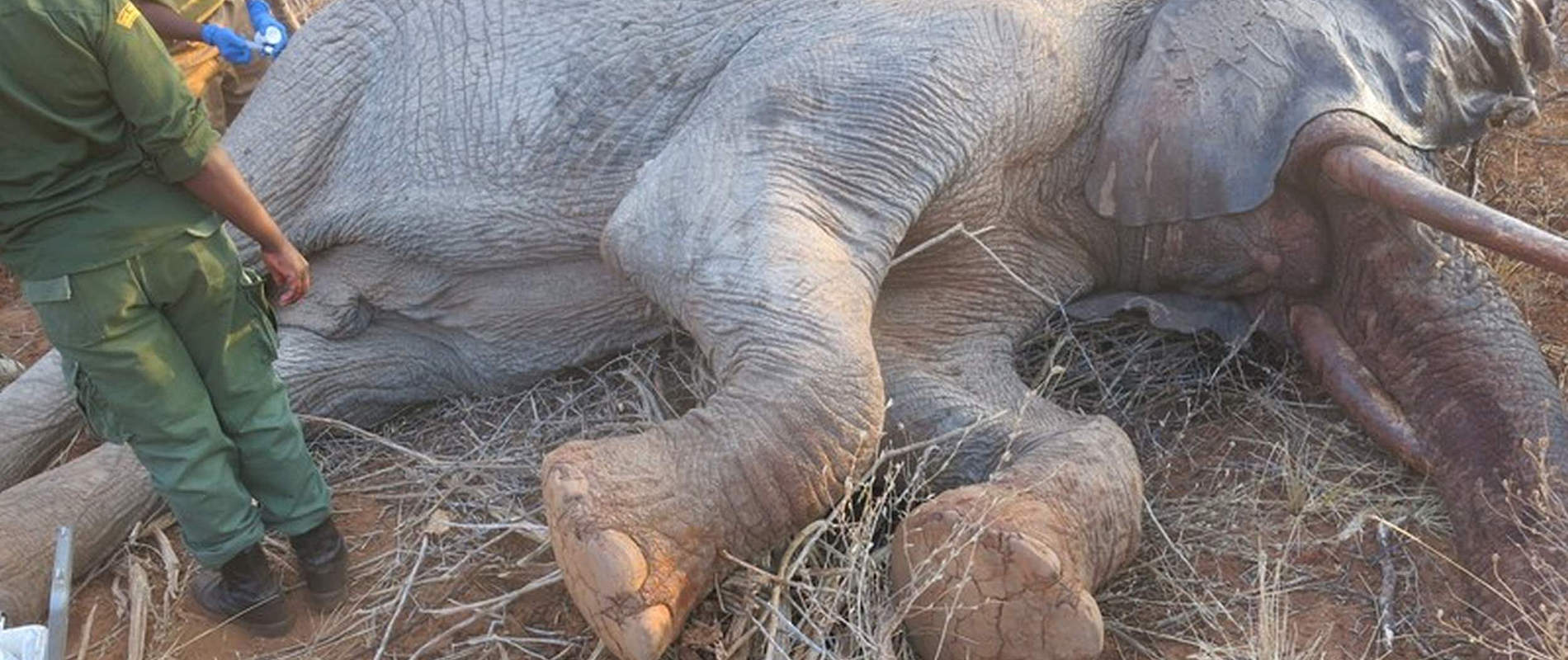FIELD VETERINARY REPORT FOR SOUTHERN CONSERVATION AREA (MVU) FOR THE MONTH OF SEPTEMBER 2015 Reported by Dr
FIELD VETERINARY REPORT FOR SOUTHERN CONSERVATION AREA (MVU) FOR THE MONTH OF SEPTEMBER 2015
Reported by Dr. Michael Njoroge
INTRODUCTION
SCA-mvu during this month was faced with a number of cases spanning the entire Amboseli and Tsavo ecosystem while holding brief for the TCA-MVU. There has been a gradual increase in the number of cases probably due to the dry weather season.
Case#1 Treatment of injured elephant
Date: 3rd September 2015
Species: African Elephant
Sex: Male
Age: 20-30 yrs
Location: Ithumba
History
The veterinary team while trying to locate a reported injured elephant spotted a male elephant with a suspected arrow head injury in the left forelimb. Plans were made on how to immobilize and treat the elephant. The elephant was darted at the water hole for examination and treatment.
Immobilization
Etorphine Hcl (0.98%) (M99®) (Norvatis South Africa (Pty) Ltd) 18mg topped up with water for injection in a 3 ml dan - inject dart was prepared. Darting was carried out using the Dan Inject system and was relatively easy at the water hole despite the thick vegetation. The elephant went down on lateral recumbence after 15 minutes. Using a tractor, the elephant was flipped over for easy access of the wound. The trunk was maintained patent using a piece of stick placed across the nostril entrances. The temperature was high hence plenty of water was doused on the elephant to keep the body temperatures low. The ears were used as blindfold.

Examination and Treatment
On physical examination the elephant had an approximately 5 inch deep wound (3-4 weeks old) on the left fore limb. The wound was septic and had necrotic tissue. The wound had been caused by an arrow which was retrieved from the wound. The dead tissue was debrided and removed. The wound was then thoroughly cleaned using clean water and Hydrogen Peroxide.


It was then lavaged using tincture of Iodine. An opening on the ventral side of the wound was made for easy drainage to prevent further infection. Topical antibiotic cream and green clay was then applied into the wound to facilitate healing and avoid infection. The elephant was then injected with 100 ml Betamox L.A, 1200 mg Clindamycin (Dalacin C) and 100 ml Dexamethasone at different sites intramuscularly. The entire operation lasted about 25 minutes.
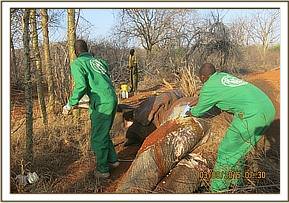
Reversal of immobilization
Diprenorphine Hydrochloride (60mgs) into the ear vein was used. It took about 6 minutes to be fully awake from anaesthesia.

Prognosis
Good
Case #2 Treatment of injured elephant
Date: 3rd September 2015
Species: African Elephant
Sex: Male
Age: 40-45 yrs
Location: Ithumba
History
Rangers at Ithumba DSWT stockade reported a case of an injured male elephant at Ithumba. The veterinary team located the elephant at the water hole and decided to dart,examine and treat the elephant.
Immobilization
Etorphine Hcl (0.98%) (M99®) (Norvatis South Africa (Pty) Ltd) 18mg topped up with water for injection in a 3 ml dan - inject dart was prepared. Darting was carried out using the Dan Inject system and was relatively easy from a vehicle at the water hole. The elephant went down on lateral recumbence after 9 minutes. The trunk was maintained patent using a piece of stick placed across the nostril entrances. The temperature was high hence plenty of water was doused on the elephant to keep the body temperatures low. The ears were used as blindfold.
Examination and Treatment
On physical examination the elephant had an approximately 12 inch deep wound (1 month old) on the right flank region but close to the hip region. The wound was septic and had necrotic tissue. The wound had been caused by an arrow which the team managed to retrieve from the wound.
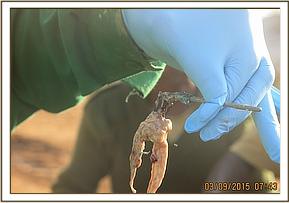
The dead tissue was debrided and removed. The wound was then thoroughly cleaned using clean water and Hydrogen Peroxide.
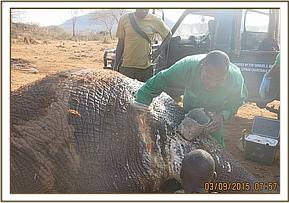

It was then lavaged using tincture of Iodine. Topical antibiotic cream and green clay was then applied into the wound to facilitate healing and avoid infection.
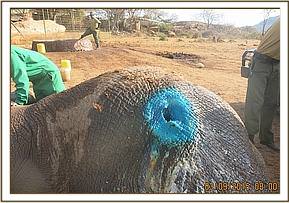
The elephant was then injected with 100 ml Betamox L.A, 1200 mg Clindamycin (Dalacin C) and 100 ml Dexamethasone at different sites intramuscularly. The entire operation lasted about 25 minutes.
Reversal of immobilization
Diprenorphine Hydrochloride (60mgs) into the ear vein was used. It took about 4 minutes to be fully awake from anaesthesia.

Prognosis
Good
Case#3 Treatment of injured elephant
Date: 7th September 2015
Species: African Elephant
Sex: Male
Age: 30-35 yrs
Location: Amboseli National Park
History
The adult male elephant was spotted within the park while performing routine patrol. A decision was made to immobilize and treat the elephant. The elephant was in a bushy area hence the DSWT was requested for darting. It was relatively easy from the helicopter though the terrain was rough and bushy.
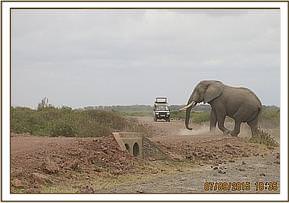
Immobilization
The elephant was immobilized using 17 mgs Etorphine Hydrochloride in a 3cc dart toped up using water for injection. Darting was done using Dan-inject system from the helicopter. Full immobilization took place after 7 minutes and he fell on lateral recumbency. With the help of a land cruiser, the elephant was flipped over for easy access to the wound. The trunk was maintained patent using a piece of stick placed across the nostril entrances. The ears were used as blindfold. Plenty of water was doused on the ears (pinnae) and the entire body to help cool the elephant during the operation.

Examination and Treatment
On examination, the elephant was in fair body condition. He had a serious wound was on the right flank region.
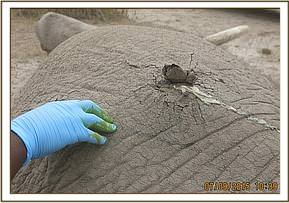
The wound had 2 openings and was likely to have been caused by a spear thrown from a platform. The dead tissue was debrided and removed. The wound was then thoroughly cleaned using water and Hydrogen Peroxide. It was then lavaged using tincture of Iodine. Topical antibiotic cream, spray and green clay was then applied into the wound to facilitate healing and avoid infection.
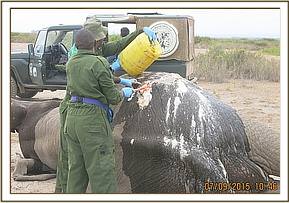

The elephant was then injected with 200 ml Amoxcycillin L.A 20% and 100 ml dexamethasone and at different sites intramuscularly. The entire operation lasted about 50 minutes.
Reversal of immobilization
Diprenorphine Hydrochloride (54mgs) into the ear vein was used. The elephant was up in 4 minutes and walked away.
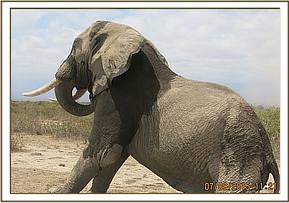
2nd Treatment
This was carried out after 2 weeks. Procedure was as during the 1st treatment though this time darting was from a motor vehicle. Great signs of improvement were observed and the elephant was given a clean bill of health.
Prognosis
Prognosis is good
Case#4 RESCUING AN INFANT ZEBRA
Date: 12th September 2015
Species: Zebra
Sex: Male
Age: 3 weeks
Location: Amboseli
History
A young zebra was reported abandoned in Amboseli by rangers. The mother could not be seen hence reunion was impossible. A decision was made to relocate him the Nairobi animal orphanage.
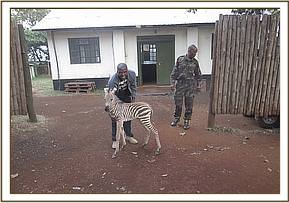
Immobilization
Physical restraint was used due to the age of the zebra. Using a landcruiser the young zebra was relocated to the orphanage for further nurturing and care.
The zebra is in good health and chances of survival high.
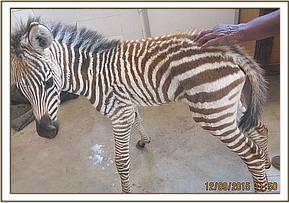
Case#5 RESCUE OF SUB ADULT ELAND
Date: 18th September 2015
Species: Eland
Sex: Male
Age: Sub adult
History
An eland was reported to have been spotted trapped in a 60 acre electric fenced plot in Lemongo area of Amboseli ecosystem. The eland could not jump over the fence and it was evident he had been stuck in the farm for about 1 week. He was dehydrated and starved. A decision was made to relocate him to the Amboseli National park.


Immobilization
The eland was immobilized using Etorphine HCL 7 mg and Azerperone 50 mg. He was fully immobilized after 5 min. He was loaded into a land cruise and relocated to Amboseli National Park after reviving using 24 mg diprenorphine HCL.
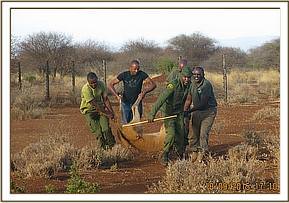

CASE#6 SAVING A SNARED BLACK RHINO
Date: 20th September 2015
Species: Black Rhino (Diceros bicornis)
Sex: Male
Age: 3 yrs
Location: Mukururo
History
Back ground information
Informed by daily camera trap images, the Mukururo Rhino monitoring teams quickly raised an alarm that sparked a series of events with one objective; saving baby Bahati, an orphaned baby Rhino that narrowly escaped a deadly poaching incident that robbed him of his mother a year ago. Bahati was apparently walking round with a woven wire (cable) snare and was getting tighter and tighter due to the front feet treading.
Championed by the Big Life Foundation and supported by other sister conservation giants (Northern Rangelands Trust, David Sheldrick Wildlife Trust) and fully backed by the Kenya Wildlife Service, resources were mobilized and a search kicked off, both ground and aerial. The first three days were unsuccessful but an evidently invisible aluta continua spirit finally paid off the fourth day. Joy, tribulation, and rejuvenation momentarily reined the air when Bahati was spotted and darted from a helicopter.
Immobilisation
Etorphine Hcl (0.98%) (M99®) (Norvatis South Africa (Pty) Ltd) 3.5mg and 50mgs Azaperone topped up with water for injection in a 3 ml dan - inject dart was prepared. Darting was carried out using the Dan Inject system from a Helicopter.
All effort was made to get the Rhino to a more secure point before the full immobilization effect but the Chyulu’s rugged, rocky, and thickly covered bushes were a great hindrance. The Rhino finally went down in lateral recumbence after ducking into a totally inaccessible point. This called for Extra Emergence effort that saw critical personnel being airlifted to the Rhino site. Sadly, Bahati had already succumbed.
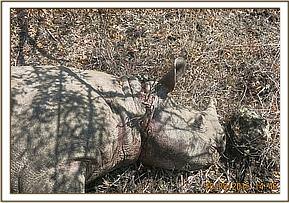
Cause of death
A differential diagnosis suggested the sceptic 5cm deep wire cut around the neck lead to bacterial infection and hence septicaemia.
Hyperthermia and hypoxia caused by the effect of the narcotics, high temperatures in the region and the tight snare were other obvious complications that must have contributed to the animal’s instantaneous collapse and death.
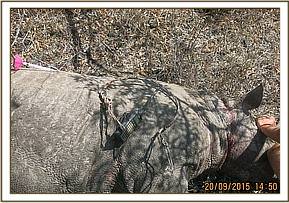
The two Rhino horns were thus retrieved and handed over to the KWS (in charge Mukururo station).
Case#7 Treatment of injured elephant at Ithumba
Date: 22nd September 2015S
Species: African Elephant
Sex: Male
Age: 30-35 yrs
Location: Ithumba
History
The adult male elephant was spotted within the park while performing an aerial reece. A serious sceptic wound was visible from a light aircraft. A decision was made to immobilize and treat the elephant. The veterinary team attended to the case.
Immobilization
The elephant was immobilized using 17 mgs Etorphine Hydrochloride in a 3cc dart toped up using water for injection. Darting was done using Dan-inject system from a vehicle. The elephant ducked int the thick nearby bush and disappeared within sight. A thorough search was embarked on for the search of the darted elephant. The search took about 1 hour and the elephant was spotted on a ridge. The trunk was maintained patent using a piece of stick placed across the nostril entrances. The ears were used as blindfold. Plenty of water was doused on the ears (pinnae) and the entire body to help cool the elephant during the operation.
Examination and Treatment
On examination, the elephant was weak and had a poor body condition. He had 2 serious wound was on the dorsal flank region close to the thoracic region and rear hind limb. The wound was deep (aprox. 90 cm), with a clean cut and sceptic. It is likely to have been caused by an arrow head. The dead tissue was debrided and removed. The wound was then thoroughly cleaned using water and Hydrogen Peroxide. It was then lavaged using tincture of Iodine. Topical antibiotic cream, spray and green clay was then applied into the wound to facilitate healing and avoid infection. The elephant was then injected with 200 ml Amoxcycillin L.A 20% and 100 ml Flunixine meglumine and at different sites intramuscularly.

Reversal of immobilization
Diprenorphine Hydrochloride (54mgs) into the ear vein was used. Owing to his weakness, the elephant could not get up. Respiration and pulse rate went down. Resuscitation was attempted for about 15 minutes but sadly the elephant died.
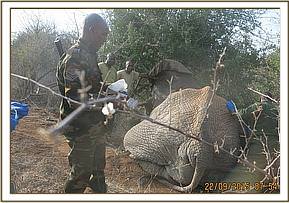
Case#8 Treatment of injured elephant at Ithumba
Date: 25th September 2015
Species: African Elephant
Sex: Female
Age: 25-30 yrs
History
The elephant was spotted while searching for a reported injured elephant at the Ithumba stockade. The wound was serious and necessitated darting and treatment. The elephant was darted from a vehicle.
Immobilization
The elephant was immobilized using 18 mgs Etorphine Hydrochloride in a 3cc dart toped up using water for injection. Darting was done using the Dan Inject system and was done from a helicopter. The elephant went down on dog sitting position after 7 minutes. He was the flipped over to access the wound. The trunk was maintained patent using a piece of stick placed across the nostril entrances. The temperature was high hence plenty of water was doused on the elephant to keep the body temperatures low. The ears were used as blindfold.
Examination and Treatment
On physical examination the elephant had an approximately 20 cm diameter wound (approx. 1 month old) on the dorsal flank region in the thoracic region. The wound was septic and had necrotic tissue. The wound had been caused by an arrow head which had fallen off with time but caused massive tissue damage.
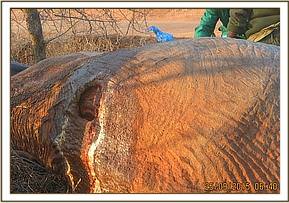
The wound was thoroughly cleaned using water and Hydrogen Peroxide. It was then lavaged using tincture of Iodine. Topical antibiotic cream and green clay was then applied into the wound to facilitate healing and avoid infection. The elephant was then injected with 200 ml Betamox L.A and 100 ml Dexamethasone at different sites intramuscularly. The entire operation lasted about 20 minutes.
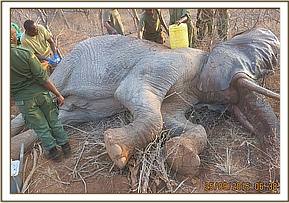

Reversal of immobilization
Diprenorphine Hydrochloride (54mgs) into the ear vein was used. It took about 4 minutes to be fully awake from anaesthesia.
Case #9 Treatment of injured elephant
Date: 28th September 2015
Species: African Elephant
Sex: Male
Age: 35-40 yrs
Location: Tsavo East National Park (Salt Lick)
History
This was spotted in due course of searching for a reported injured elephant. It had a fairly large swelling on the left flank region with a little oozing pus. With an already prepared dart, this was immobilized and attended to.
Immobilization
EtorphineHcl (0.98%) (M99®) (Norvatis South Africa (Pty) Ltd) 18mg topped up with water for injection in a 3 ml Dan - inject dart was prepared. Darting was carried out using the Dan Inject system from a vehicle. After 10 minutes, the bull went recumbent but on the wrong side and was thus rolled over to expose the wounded side for treatment. The trunk was maintained patent using a piece of stick placed across the nostril entrances. The temperature was high hence plenty of water was doused on the elephant to keep the body temperatures low. The ears were used as blindfold.
Examination and Treatment
On physical examination the elephant had a healing wound with a little pus. The wound, most likely inflicted by an arrow, had come off with time.
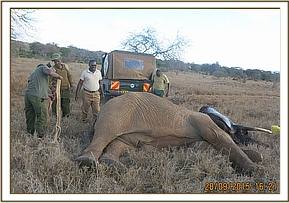

This was thoroughly cleaned using clean water and Hydrogen Peroxide. It was then lavaged using tincture of Iodine. Topical antibiotic cream and green clay was then applied into the wound to facilitate healing and avoid infection. The elephant was then injected with 100 ml Betamox L.A and 100 ml Dexamethasone at different sites intramuscularly. The entire operation lasted about 15 minutes.


Reversal of immobilization
Diprenorphine Hydrochloride (60mgs) into the ear vein was used. It took 5 minutes to get up and walk away from the site.

Prognosis
Good
The Southern Conservation Area Mobile Veterinary Unit is grateful to all individuals and organisations that played a role in assisting us towards achieving our goal. Many thanks to The David Sheldrick Wildlife Trust, The Samuel J and Ethel Lefrak charitable trust and The Kenya Wildlife Service for their continued support to this unit which aims at immediate response to clinical intervention, wildlife rescues and alleviating wildlife suffering.
Southern Conservation Mobile veterinary Unit (Amboseli ecosystem)
